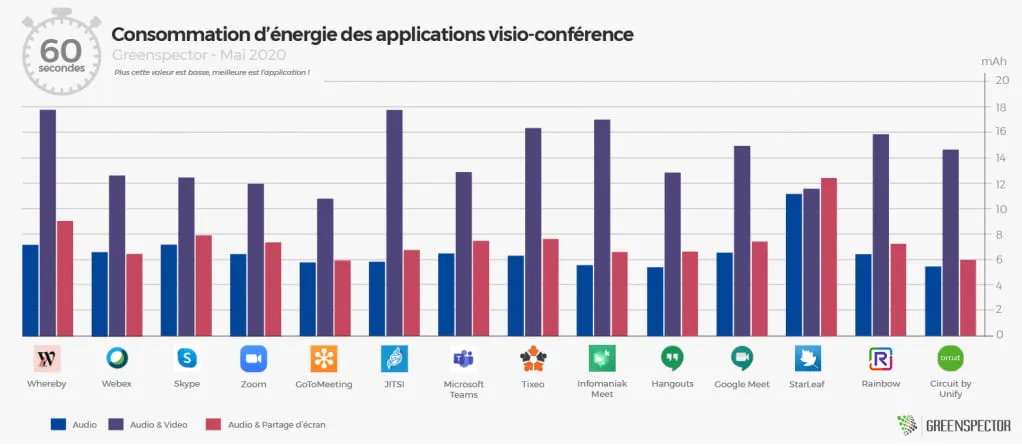A taboo subject just a few months ago, the health crisis has caused telecommuting to explode in almost all companies, to the point where some have decided to make it the norm.
As it reduces daily travel, it is naturally seen as an effective lever for reducing a company's CO2 emissions.
However, this is not always the case. Indeed, the French Environment and Energy Management Agency (ADEME) has just published a comprehensive report, concluding that telecommuting can lead to various increases in energy consumption.
Here's a list of best practices to implement in your company to ensure that you reduce your carbon footprint.
1. Understand how your employees get to work every day
Yes, for this first good practice we ask you to work.
Because if you want to make telecommuting more common as part of your drive to reduce emissions, it's first crucial to quantify the carbon impact of your employees' daily commutes.
Indeed, it should be noted that the main positive effect of teleworking in terms of CO2 emissions is the reduction in emissions linked to daily commuting. The challenge of this exercise is to ensure that the reduction in commuting emissions is greater than the increase in emissions resulting from the introduction of teleworking.
So, if the majority of your employees come by car, there's a good chance that telecommuting will help you reduce your carbon footprint.
But if a majority of your employees come to the office on foot, by bike or by metro, then there's a good chance that telecommuting will increase your emissions.
There is, however, one case where these rules may not apply: it's when your employer "adapts" the size of the offices according to the number of on-site/teleworking employees. We'll talk more about this below!
2. Draw up a customized teleworking plan by country
One of the most significant rebound effects of telecommuting is what ADEME calls the "Housing" effect. This is the increase in household electricity consumption attributed to the employee's professional activity.
In fact, working from home will lead to an increase in heating, lighting, internet, electrical equipment, etc. ADEME estimates that telecommuting leads to an increase in electricity consumption of 7.5kWh per day.
As the carbon mix is different in each country, here is the carbon impact per country of this "rebound effect":
- France: +20.7kgCO2e per day
- Germany: +167.1kgCO2 per day
- China: +278.7kgCO2 per day!
The benefits of telecommuting on the carbon footprint are therefore different depending on the country you're in.

3. Reduce the use of video in videoconferencing
An essential tool for telecommuting, videoconferencing places heavy demands on servers, which consume energy. They therefore de facto emit greenhouse gases.
According to a 2020 study by Thierry Leboucq, one minute of videoconferencing emits around 1g of CO2 per minute.
However, the disparities between use with and without video are fundamental, since video conferencing without video emits on average 2 to 3 times less CO2 (depending on the application used).
In short, for small, everyday meetings, don't hesitate to cut the video!

4. Extend the life of your IT equipment or switch to reconditioned equipment
To ensure optimum comfort for teleworking employees, companies have not hesitated to invest in IT equipment.
Indeed, according to a study carried out by BNP Paribas 3 Step IT, 83% of French companies purchased additional equipment during the health crisis. What's more, the widespread adoption of teleworking will lead to a doubling in the purchase of certain computer equipment (dual screens, ergonomic chairs, etc.).
To minimize this impact, increasing the lifespan of your IT equipment is one of the most effective levers. To do this, you can opt for a systematic approach to repairing your systems (many IT suppliers offer this option), or opt for a supplier of reconditioned IT equipment.
This advice also applies to non-teleworkers 😉
5. Flex Office
By Flex Office, we mean all "office on demand" solutions.
Are 50% of your employees teleworking? Why would you keep 100% of your original square meters? You could consider reducing your surface area by 50%, and renting the remaining 50% to another 50% telecommuting company.
Although still marginal, these types of solutions are growing rapidly and, according to ADEME, represent the most effective way of maximizing the positive effects of teleworking.
Implementing it nevertheless requires a certain amount of work, since for many companies it involves a change of premises and culture. What's more, it requires a certain amount of organization, as the company will need to manage staff schedules and available office space.
That's it! If you can put all that in place, it's already very good. 👏
Don't hesitate to contact if you have any questions about this article!


.svg)



